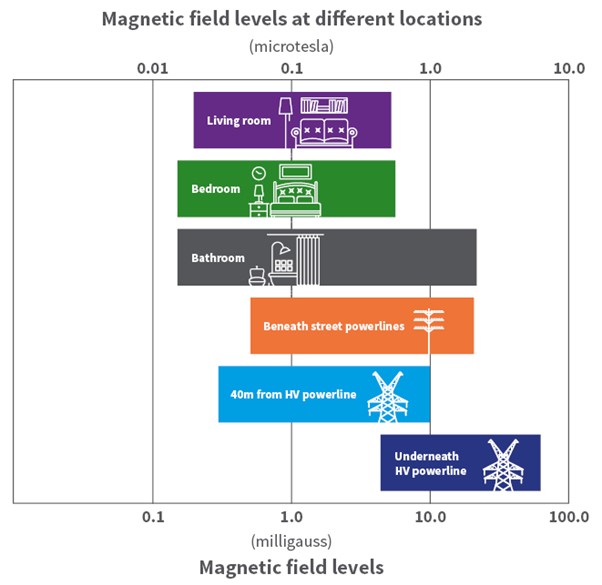Electric & magnetic fields
Electric and Magnetic Fields (EMFs) are produced by any appliance with electric current flowing through it. That includes not only powerlines but just about every electrical appliance used in the house.
Powerlines generally contribute little to the electrical fields that can be measured inside a house or office. This is because the walls of the building, in fact any solid object, create a shield from the electrical field. A typical house generally shields at least 90 per cent of the electrical fields from outside.
EMFs and powerlines
Magnetic fields associated with powerlines depend on the amount of current flowing and the distance from the powerline. Fields rapidly decrease in strength with distance, therefore inside a house, magnetic fields from nearby powerlines are usually similar to that from wiring and appliances. In many cases, high voltage lines are constructed on easements where building is not permitted.
We recognise the community concern about the potential health impacts of electric and magnetic fields (EMFS). We rely on expert advice from health authorities in Australia and around the world to ensure that we as a business, practise prudent avoidance when designing Queensland’s electricity network.
Industry expertise
The Australian Radiation Protection and Nuclear Safety Agency (ARPANSA) is the Australian Government’s primary authority on radiation protection and nuclear safety. ARPANSA undertakes research, provides services, and promotes national uniformity and the implementation of international best practice across all jurisdictions
The Energy Networks Association (ENA) is the National Industry Association representing the businesses operating Australia’s electricity transmission and distribution and gas distribution networks.
Our response to EMF
As an Energy Networks Association (ENA) member, we adopt an approach of prudent avoidance. This involves designing, locating and operating electricity assets to minimise field strengths and offer the best value to electricity users.
We address concerns about EMF exposure by:
- Operating all powerlines and substations in our distribution area within current Australian standards
- Keeping informed about engineering and scientific research on EMF exposure and reviewing its policies in the light of the most up-to-date research findings, with particular emphasis on the findings of eminent scientific review panels
- Actively participating in industry and other forums that have the objective of broadening scientific knowledge of the effects of EMFs
- Responding constructively and consistently to employee and community inquiries and referring inquirers to authoritative sources of information
- Practising prudent avoidance (as established by good engineering and planning practice as it is applied, or is to be applied, at our operating locations) in siting new generation, transmission and distribution facilities
- Undertaking monitoring and analysis of EMF levels associated with its network
- Prudently managing public, and our employees' and contractors' occupational exposure to EMFs associated with our network.
Does undergrounding stop EMFs?
Putting powerlines underground does not stop EMFs. The earth does not shield magnetic fields. Design decisions such as using multiple phases (wires) and laying them closer together underground can help to reduce EMF levels. Importantly, similar design decisions can often be used with overhead wires to help cancel out magnetic fields.
Common sources of EMFs
The following figure shows typical magnetic field levels at different locations (Source: Electricity and health | ARPANSA).
Detailed information on electricity and health can be found on the ARPANSA website and the ENA Australia EMF Management Handbook.


